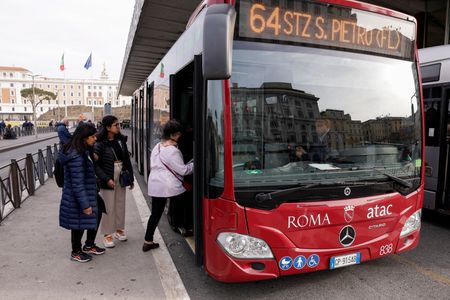By Gavin Jones, Alberto Chiumento and Angelo Amante
ROME (Reuters) – After three decades of wage stagnation, workers in Italy have plenty to protest about, yet strikes over pay are rare and seldom last more than a day, prompting growing questions about the role of the country’s trade unions.
Italy is the only advanced country where inflation-adjusted wages declined between 1990 and 2020, data from the Organisation for Economic Cooperation and Development shows, leading to weak consumer spending and anaemic growth.
Pay has picked up more recently, rising by 9% between the third quarter of 2021 and the second quarter of last year, but it still lagged inflation and wage growth of 14% in Germany and 11% in France, according to German central bank data.
Economic factors are partly to blame, including Italy’s employment rate of just 67%, the lowest in the 20-nation euro zone and giving workers little bargaining power.
Yet many labour experts and workers say the unions also bear a heavy responsibility.
“Trade unions in Italy have mutated to become mainly service providers,” said Filippo Barbera, a sociology professor at Turin University. “They help you do your tax returns and calculate what your pension will be, but they won’t take on employers to secure salary rises.”
After a colourful, banner-waving national strike on November 29 against planned cuts to government spending on social security, public services and investments, Maurizio Landini, the fiery head of the largest union confederation, the CGIL, vowed to “turn the country upside down.”
The protest disrupted public transport, schools and hospitals, but like virtually all strikes in Italy, it only lasted a day and achieved no tangible results.
A CGIL spokesman said Italy’s poor wage growth was mainly due to years of labour reforms that had weakened job protection. The union has instigated a national referendum to vote on whether to repeal reforms that made firing staff easier and promoted short-term contracts.
The ballot must be held between April 15 and June 15, but the government has not yet set the date.
The CGIL is also pushing for legislation to prevent unduly low wage contracts, though this has little support among the right-wing ruling coalition and no bill has yet been presented to parliament.
While union power has declined worldwide in recent decades, analysts say strikes are more focused and effective in countries such as Germany, France and the United States, even though they have far lower union membership than Italy.
Staff at U.S. plane maker Boeing in November secured a 38% pay rise over four years, after a seven-week walkout, while in Germany thousands of workers at carmaker Volkswagen held rolling strikes against layoffs before finally reaching a deal in December.
PENSIONER-HEAVY UNIONS
Italian union membership is relatively high, at around a third of all workers, but big numbers don’t add up to militancy.
French unionisation is only a third of Italy’s, but France is among the European countries in which most days per year were lost to strikes in 2020-2023, European Trade Union Institute data shows. Italy stopped providing its data in 2009.
A study by Katia Pilati, a sociologist and strike expert at Trento University, found that over 90% of major strikes in Italy lasted a day or less, while in the United States 80% last two days or longer.
Almost half the CGIL’s 5.1 million members are pensioners, whose interests are represented by the union when it lobbies the government. Retirees also make up over a third of the other main confederations, the CISL and the UIL.
Salvatore Amoruso, a 40-year-old logistics warehouse worker in Rome, left the CGIL with a group of colleagues in 2015 to join the more militant Cobas grass-roots organisation, which he said fought much harder for its members from a raft of sectors from health workers to metal workers.
“We have almost doubled our wages and obtained lunch vouchers, holiday pay and sick leave,” Amoruso said. “It’s been a minor revolution in terms of pay, conditions and dignity.”
TOO POOR TO STRIKE
Italy’s workers are in a vulnerable position. As in other countries, they get no pay when they strike, but unlike in Germany and France, neither do the unions organise meaningful strike funds to compensate them for the lost income.
This means many low-paid workers feel they cannot afford to strike, said Vincenzo Ferrante, who teaches trade union law at Milan’s Cattolica University.
“It’s not hard to understand why there have been so few drawn-out Italian strikes in the last 30 years,” he said. “Most last a day, half a day, or just a few hours.”
Trento University’s Pilati said Italian stoppages tend to be “defensive”, aimed at protecting jobs and working conditions, rather than geared to getting a pay rise.
Germany has more structured and effective procedures: if initial negotiations over a pay claim are unsuccessful, a union will typically call one or two “warning strikes,” normally lasting a single day.
“These are intended to tell the employer the union means business and is ready to open a real fight,” said Thorsten Schulten, who teaches labour policy at Germany’s Tubingen University.
If that does not produce the desired effect, the union calls an open-ended strike which can sometimes run for weeks.
In Italy, national wage contracts are routinely renewed with a delay of months or even years, producing a constant erosion of purchasing power.
At the end of 2024, the contracts of over half the 13 million Italian workers covered by collective wage agreements had expired, according to national statistics bureau ISTAT. The average delay in renewing them was 22 months.
The large unions have accepted this situation for years.
“To make things better we need more strikes, not fewer,” said Emiliano Brancaccio, an economics professor at Naples University.
(Writing by Gavin Jones, additional reporting by Maria Martinez in Berlin and Leigh Thomas in Paris, editing by Susan Fenton)













